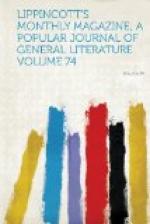It was not only at Stokesay—I have written the name at last, and I will not efface it—that I lingered a while on the quiet platform of the keep to enjoy the complete impression so overtaken. I spent such another half hour at Ludlow, which is a much grander and more famous monument. Ludlow, however, is a ruin—the most impressive and magnificent of ruins. The charming old town and the admirable castle form a capital object of pilgrimage. Ludlow is an excellent example of a small English provincial town that has not been soiled and disfigured by industry: I remember there no tall chimneys and smoke-streamers, with their attendant purlieus and slums. The little city is perched upon a hill near which the goodly Severn wanders, and it has a noticeable air of civic dignity. Its streets are wide and clean, empty and a little grass-grown, and bordered with spacious, soberly-ornamental brick houses, which look as if there had been more going on in them in the first decade of the century than there is in the present, but which can still, nevertheless, hold up their heads and keep their window-panes clear, their knockers brilliant and their doorsteps whitened. The place looks as if seventy years ago it had been the centre of a large provincial society, and as if that society had been very “good of its kind.” It must have transported itself to Ludlow for the season—in rumbling coaches and heavyish curricles—and there entertained itself in decent emulation of that metropolis which a choice of railway-lines had not as yet placed within its immediate reach. It had balls at the assembly-rooms; it had Mrs. Siddons to play; it had Catalani to sing. Miss Austin’s and Miss Edgeworth’s heroines might perfectly well have had their first love-affair there: a journey to Ludlow would certainly have been a great event to Fanny Price or Anne Eliot, to Helen or Belinda. It is a place on which a provincial “gentry” has left a sensible stamp. I have seldom seen so good a collection of houses of the period between the elder picturesqueness and the modern baldness. Such places, such houses, such relics and intimations, always carry me back to the near antiquity of that pre-Victorian England which it is still easy for a stranger to picture with a certain vividness, thanks to the partial survival of many of its characteristics. It is still easy for a stranger who has stayed a while




